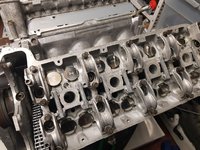A few members here mentioned that the tubes slighly pop out of place (not the end cap but the tube itself).
AFAIK the Camshaft bridges don't hold the tubes firmly, there is ~2 mm gap between the oil tube tabs and the bottom of the bridge
There is a small gap - but not as much as 2mm. More like 0.8 - 1.0mm.
The small gap does not impact on the sealing of the tubes at all. The oiler tubes and O Rings locate into a machined bore in the head. Thus the O ring can make 100% seal no matter where exactly it is resting in place. Indeed the first time the engine is fired up and under 3+bar oil pressure it is likely they will pop out the small amount and be out against the cam bearing bracket. This small amount of play is likely inbuilt to allow for repeated heat / cooling cycles and thermal expansion. It they made it a tight fit the ears might fracture on the tubes.
For me this small gap is a non-issue.
That was my understanding too. So what did metal tubes changed? It's been about 300 miles since change and the clutter is down by 2/3... You can see from the picture of my valvetrain that aside from conventional oil staining, it's clean - no gunk anywhere. When removing plastic tubes, each drained oil, so I don't think any were plugged up.
@gsxr, @JC220, any educated guesses?
@gerryvz, I sources metal tubes from @J-Sauce back in 2015. He had me o-rings put on them
Ref why you may have noticed an improvement here – the plastic tubes over many years of use and heat cycles could well have changed shape very slightly (where they seal in the head) and / or shrunk a very small amount in size. Combined with what Gerry said about the O rings getting age / heat hardened and possibly flat spotted too both of these occurrences could lead to some oil escaping past the seals and subsequently lowering the oil supply to the hydraulic lifters by a small amount. And given that these oiler tubes are all fed from the same oil gallery if one or more started to lose pressure then all other tube’s pressure could be impacted also. Not 100% convinced on this but it is a possibility. What is more likely is this-
When you remove the plastic oiler tubes they have cooled down. There could be hairline cracks or fissures in one or more of those original plastic tubes that only open up / become visible when at operating temperature and under oil pressure. Whereas the aluminium tubes do not have this weakness. In any event we know that these were changed from aluminium to plastic for cost cutting measures more likely than anything else so best get them changed to enjoy long term reliability.
The seal rings are inexpensive and should always be renewed with genuine parts at any point when removing and installing replacement tubes.





